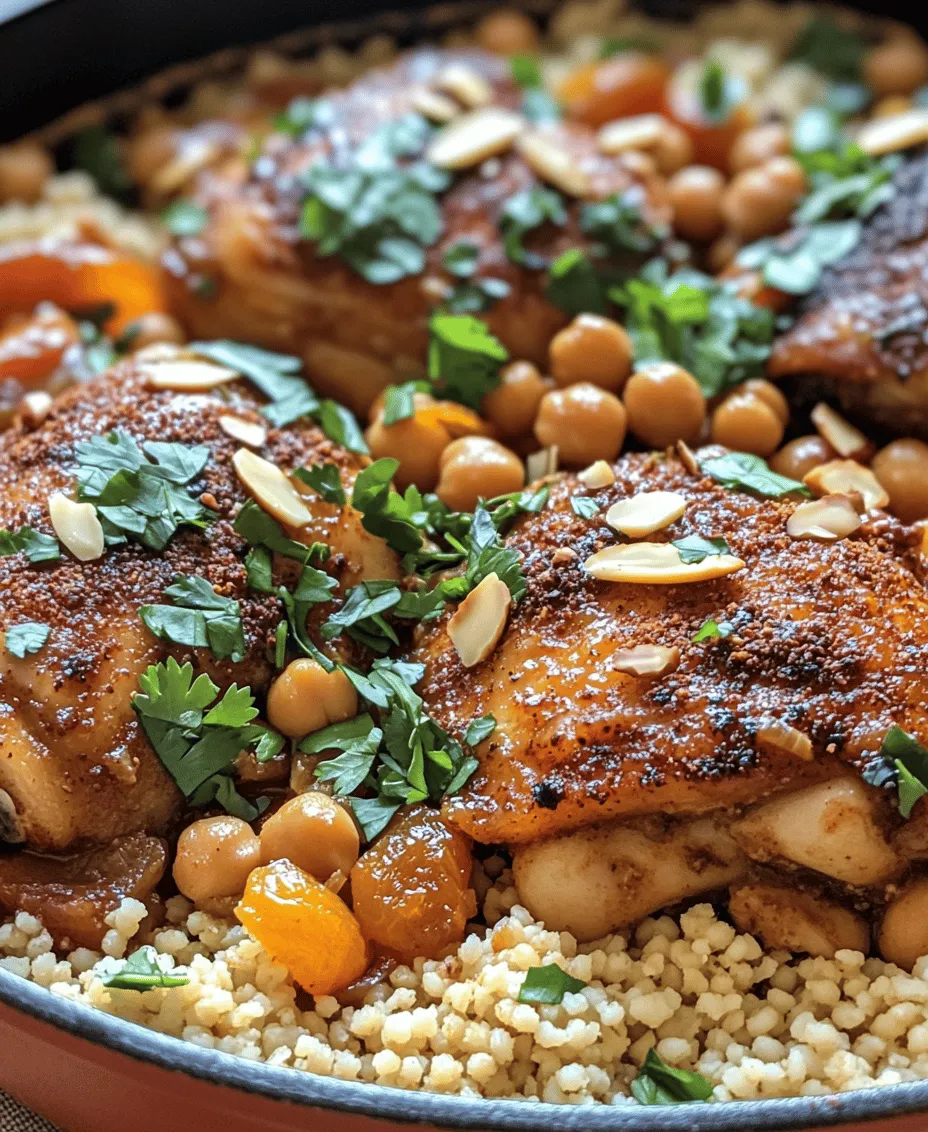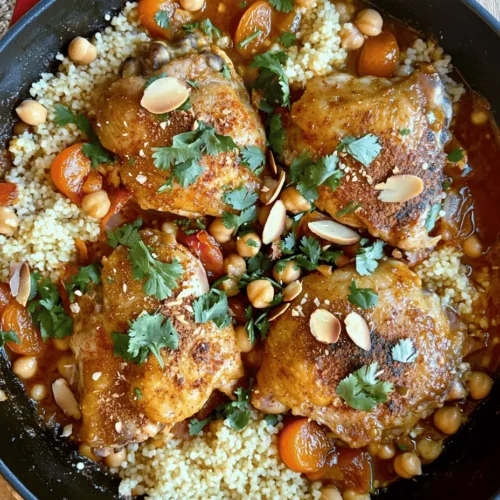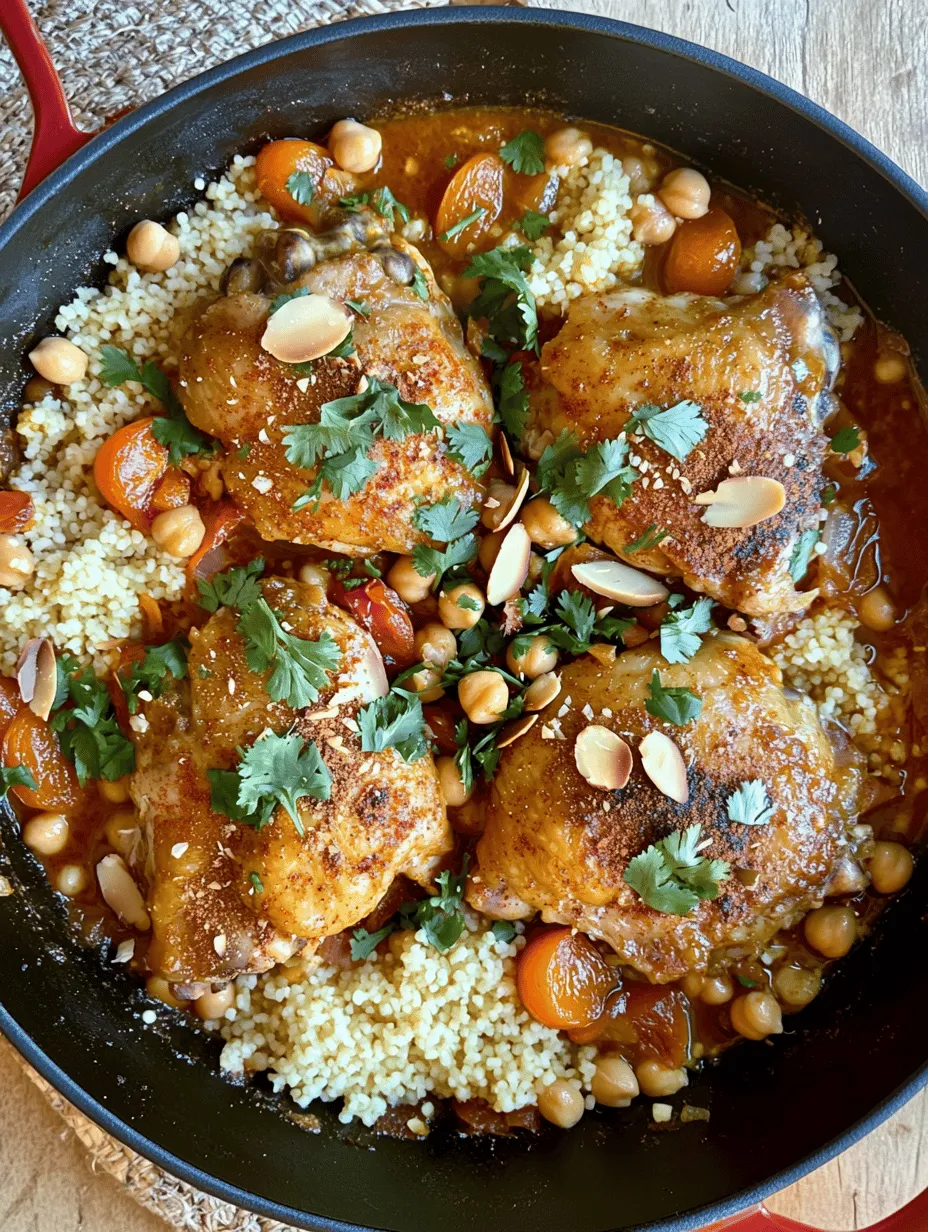Introduction
Moroccan cuisine is a vibrant tapestry of flavors, colors, and aromas that reflect the country’s rich cultural heritage and geographical diversity. Renowned for its ability to blend spices in a way that tantalizes the palate, Moroccan dishes often tell a story of tradition, history, and the warmth of family gatherings. Among the standout recipes in this culinary landscape is Moroccan Spiced Chicken, a dish that embodies the essence of North African cooking. This aromatic chicken is not only a feast for the senses but also a perfect centerpiece for family dinners or gatherings, ensuring that every bite is a delightful experience.
What makes Moroccan Spiced Chicken truly special is its unique combination of spices and ingredients. The dish features a symphony of flavors from warm spices like cumin and cinnamon to the brightness of fresh lemon, creating a balance that is both comforting and exotic. The addition of chickpeas and apricots lends a delightful texture and sweetness, making this dish a well-rounded meal that is satisfying and wholesome.
In this article, we will dive deeper into the characteristics of Moroccan cuisine, spotlight the key ingredients that bring Moroccan Spiced Chicken to life, and guide you through the initial preparation steps to create this flavorful dish.
Understanding Moroccan Cuisine
Moroccan cuisine is a fusion of Berber, Arab, and Mediterranean influences, characterized by its use of a diverse array of spices and cooking techniques. One of the most defining features of Moroccan cooking is the emphasis on spices, which are not just used for flavor but also for their health benefits. Spices such as saffron, turmeric, and cumin are staples in Moroccan kitchens, each contributing its unique profile to various dishes.
Spices play a pivotal role in enhancing the flavors of Moroccan dishes. For instance, cumin adds earthiness, while cinnamon introduces a hint of sweetness, creating layers of flavor that can transform a simple meal into a culinary masterpiece. The careful balance of spices is a hallmark of Moroccan cooking, where each ingredient is chosen not just for its taste but also for the harmony it creates with others.
Traditional Moroccan cooking methods, such as tagine cooking, also contribute to the depth of flavor found in Moroccan dishes. The tagine, a conical clay pot, is designed to slow-cook meats and vegetables, allowing the flavors to meld beautifully over time. While this recipe for Moroccan Spiced Chicken can be adapted for various cooking methods, the essence of Moroccan cuisine remains rooted in the thoughtful use of spices and the communal joy of sharing a meal.
Ingredients Spotlight
Creating Moroccan Spiced Chicken requires a thoughtful selection of ingredients, each contributing to the dish’s complexity and appeal. Here’s a closer look at the essential components that make this recipe stand out:
Chicken Thighs
For this recipe, chicken thighs are the preferred choice. Unlike chicken breasts, which can dry out if overcooked, thighs are more forgiving and remain juicy thanks to their higher fat content. The rich flavor of chicken thighs allows them to absorb the spices more effectively, ensuring that every bite is bursting with flavor.
Olive Oil
Olive oil is another key ingredient in Moroccan Spiced Chicken. Not only does it add a rich, fruity flavor, but it also serves as a healthy fat that helps to tenderize the chicken during the marination process. Furthermore, cooking with olive oil enhances the absorption of fat-soluble vitamins found in the spices and herbs used in the dish.
Aromatics: Onion and Garlic
The aromatic duo of onion and garlic is fundamental in building the flavor base for Moroccan Spiced Chicken. Onions, when sautéed until caramelized, develop a sweet and savory quality that elevates the overall dish. Garlic, with its pungent and aromatic properties, adds depth and complexity. Together, these aromatics create a fragrant foundation that will infuse the chicken as it cooks.
Spices
The heart of Moroccan Spiced Chicken lies in its spice blend. Here’s a closer look at the key spices used in this recipe:
– Cumin: This spice offers a warm, earthy flavor that is a staple in Moroccan cuisine. It adds depth and enhances the overall taste profile of the dish.
– Coriander: With its citrusy notes, coriander complements the earthiness of cumin and brings a refreshing balance to the spice blend.
– Cinnamon: Often associated with sweet dishes, cinnamon also plays a crucial role in savory Moroccan recipes. Its warm sweetness adds complexity and richness to the chicken.
– Smoked Paprika: This spice introduces a subtle smokiness, enhancing the dish’s depth while providing a beautiful color to the chicken.
– Cayenne Pepper: For those who enjoy a bit of heat, cayenne pepper adds a kick that rounds out the flavors and keeps the palate engaged.
Lemon
Lemon is an essential ingredient in Moroccan Spiced Chicken, bringing brightness and acidity to the dish. The zest and juice of the lemon not only add a refreshing element but also help to tenderize the meat during the marination process. The citrusy notes from the lemon balance the richness of the chicken and the spices, creating a well-rounded flavor profile.
Chickpeas and Apricots
Chickpeas and apricots are unique additions that contribute both texture and flavor balance to Moroccan Spiced Chicken. Chickpeas add a hearty component, providing protein and fiber that make the dish more filling. Their nutty flavor pairs beautifully with the spices. Apricots, on the other hand, introduce a touch of sweetness that contrasts with the savory elements, enhancing the overall experience of the dish.
Fresh Cilantro and Almonds
Finally, fresh cilantro and sliced almonds serve as garnishes that elevate Moroccan Spiced Chicken. Cilantro adds a burst of freshness and color, while the almonds provide a delightful crunch that contrasts with the tender chicken and chickpeas. Together, they enhance both the presentation and the flavor, making the dish visually appealing and delicious.
Preparation Steps
To create Moroccan Spiced Chicken, the preparation begins with marinating the chicken, which is crucial for flavor absorption. Here’s how to effectively marinate the chicken and prepare the aromatics:
Marinating the Chicken
Marination is an essential step in preparing Moroccan Spiced Chicken, as it allows the flavors of the spices to penetrate the meat thoroughly. To marinate the chicken effectively, follow these steps:
1. Combine the Marinade: In a bowl, whisk together olive oil, lemon juice, lemon zest, minced garlic, and the spice blend (cumin, coriander, cinnamon, smoked paprika, and cayenne pepper). Ensure that the spices are evenly distributed in the marinade.
2. Prepare the Chicken: Pat the chicken thighs dry with paper towels to remove excess moisture. This step helps the marinade adhere better and promotes even cooking.
3. Coat the Chicken: Place the chicken thighs in a large resealable plastic bag or a shallow dish. Pour the marinade over the chicken, ensuring that each piece is well coated. Seal the bag (or cover the dish) and refrigerate for at least 1 hour, preferably overnight. The longer the chicken marinates, the more flavorful it will become.
4. Bring to Room Temperature: Before cooking, remove the marinated chicken from the refrigerator and allow it to come to room temperature for about 30 minutes. This step ensures even cooking and helps the chicken retain moisture.
Sautéing Onions
While the chicken is marinating, you can prepare the aromatics, starting with the onions. Properly sautéing the onions is key to achieving perfect caramelization, which adds depth to the dish. Here’s how to do it:
1. Heat the Pan: In a large skillet or Dutch oven, heat a couple of tablespoons of olive oil over medium heat. Allow the oil to become hot but not smoking.
2. Add the Onions: Once the oil is hot, add thinly sliced onions to the pan. Stir to coat the onions in the oil.
3. Cook Slowly: Reduce the heat to medium-low and let the onions cook slowly. Stir occasionally, allowing them to soften and caramelize. This process may take about 15-20 minutes. The goal is to achieve a golden-brown color, as this enhances the overall flavor of the dish.
4. Add Garlic: When the onions are nearly caramelized, add minced garlic and cook for an additional 1-2 minutes until fragrant. Be careful not to burn the garlic, as it can become bitter if overcooked.
By following these initial preparation steps, you lay the foundation for a delicious Moroccan Spiced Chicken that will surely impress your family and friends. With a rich blend of spices, tender chicken, and the delightful balance of flavors, this dish promises to transport you to the heart of North Africa with every bite.

Cooking the Chicken: Tips for Browning and Achieving Optimal Flavor
The foundation of a great Moroccan Spiced Chicken lies in the initial cooking process, particularly how you brown the chicken. Browning not only adds an appetizing appearance but also enhances the flavor through the Maillard reaction, where amino acids and sugars react under heat, creating complex flavor compounds.
To achieve the perfect sear, choose a heavy-bottomed skillet or Dutch oven that retains heat well. Begin by heating the oil until it shimmers, then carefully add the chicken pieces, ensuring not to overcrowd the pan. Overcrowding can lead to steaming rather than browning, which diminishes the flavor. Allow the chicken to cook undisturbed for several minutes on each side until golden brown before flipping.
For those using skin-on chicken, keep the skin side down first, as this will release fat and further enhance the dish’s richness. Once browned, remove the chicken and set it aside; this step will allow you to deglaze the pan, capturing those delicious caramelized bits left behind, which will contribute to the sauce’s depth of flavor.
Incorporating Remaining Ingredients: The Significance of Layering Flavors
Once the chicken is perfectly browned, it’s time to incorporate the remaining ingredients. Layering flavors is essential in Moroccan cuisine, as it builds complexity in the dish. Start by adding chopped onions to the drippings in the pan. Sauté until translucent, allowing them to absorb the flavors left from the chicken.
Next, introduce garlic, ginger, and the signature Moroccan spices: cumin, coriander, cinnamon, and paprika. As these spices bloom in the hot oil, their aromas will fill your kitchen, signaling that the dish is coming together. Adding nuts, dried fruits (like apricots or raisins), and tomatoes will introduce sweetness and acidity, balancing the robust spices.
Don’t forget to stir frequently and scrape the bottom of the pan to incorporate all those flavorful bits. This process ensures that every bite of your Moroccan Spiced Chicken is rich and layered with nuanced flavors.
Simmering: The Science Behind Slow Cooking for Tenderness and Flavor Melding
Simmering is where the magic truly happens. After you’ve added the browned chicken back into the pot along with chicken broth or water, bring the mixture to a gentle simmer. Covering the pot helps to trap steam, making the chicken tender and juicy while also allowing the spices to meld beautifully.
The science of slow cooking involves breaking down the connective tissues in the chicken, which results in a succulent texture. This method also allows the flavors from the spices and other ingredients to infuse the chicken deeply, creating a cohesive dish. Depending on the size of your chicken pieces, simmer for about 30-45 minutes, or until the chicken is fully cooked and tender.
For an added depth of flavor, consider adding a splash of preserved lemon or olives during the last 10 minutes of cooking. These ingredients are staples in Moroccan kitchens and add a unique tanginess that rounds out the dish perfectly.
Garnishing and Serving Suggestions: Ideas for Presentation and Pairing
Presentation is key to enjoying Moroccan cuisine, as it enhances the dining experience. Once your Moroccan Spiced Chicken has simmered to perfection, it’s time to think about garnishing. Fresh herbs, such as chopped cilantro or parsley, sprinkled over the dish just before serving will not only add color but also a fresh flavor that brightens the heavy spices.
Serve the chicken on a large platter, accompanied by the sauce and vegetables, for a communal dining experience. This style reflects Moroccan traditions, where meals are shared and enjoyed together.
Flavor Profiles and Taste Analysis
The first bite of Moroccan Spiced Chicken is a journey of flavors. The initial taste is savory, with the chicken soaked in the fragrant spices, followed by a hint of sweetness from the dried fruits. As you savor the bite, the spices interact, each contributing to a harmony of flavors that include warm undertones from the cinnamon and a slight kick from paprika.
The balance of savory, sweet, and tart flavors is what makes this dish so enticing. The spices work in tandem, with cumin and coriander providing earthiness, while the cinnamon adds a warming sweetness. The tang from the preserved lemon or olives introduces a refreshing contrast, ensuring no single flavor overpowers the others.
For those who prefer a milder dish, adjusting the spice levels is easy. Simply reduce the amount of paprika and cumin, or opt for sweet paprika instead of smoked. You may also add more vegetables to the dish, such as carrots or zucchini, which will absorb the spices and mellow the overall flavor profile.
Serving Suggestions
To complement your Moroccan Spiced Chicken, consider traditional accompaniments that enhance the meal.
Couscous: A classic pairing, couscous is light and fluffy, acting as an excellent base for soaking up the rich sauce. To prepare, simply steam the couscous according to package instructions, adding a pinch of salt and a drizzle of olive oil. For added flavor, consider incorporating sautéed vegetables or toasted nuts into the couscous before serving.
Crusty Bread: A fresh loaf of crusty bread is perfect for mopping up the sauce. Baguettes or Moroccan khobz work beautifully, providing a delightful contrast to the tender chicken. Serve the bread warm, and consider presenting it on a wooden board for a rustic touch.
Pairing with Beverages: When it comes to beverages, a well-rounded wine can elevate your dining experience. A medium-bodied red, such as a Grenache or Syrah, complements the spices well. For a non-alcoholic option, consider mint tea, a traditional Moroccan drink known for its refreshing qualities, or a pomegranate juice blend that adds a sweet and tart flavor to the meal.
Cultural Significance of Moroccan Spiced Chicken
Moroccan Spiced Chicken is not just a dish; it’s a reflection of Moroccan culture and dining traditions. In Moroccan households, meals are often communal, served in shared dishes from which everyone participates in enjoying the food. This style of dining fosters a sense of togetherness and celebration, making every meal an occasion.
The preparation of Moroccan Spiced Chicken often involves family members gathering to cook together, with each person contributing their unique touch to the dish. This communal aspect is integral to Moroccan dining culture, where food is more than sustenance; it’s a means of connecting with one another.
In traditional settings, you may find the dish served over a bed of fragrant saffron-infused rice or alongside seasonal vegetables, reinforcing the connection to the land and its bountiful offerings. The use of spices not only reflects the rich history of trade in Morocco but also showcases the country’s ability to blend diverse culinary influences.
Conclusion
Moroccan Spiced Chicken is a dish that embodies the essence of Moroccan cuisine, rich in flavor, culture, and tradition. The recipe is not just about the ingredients but about the experience of cooking and sharing a meal infused with a rich cultural heritage. The process of layering flavors, the careful balance of spices, and the communal nature of serving this dish make it a perfect centerpiece for family gatherings or special occasions.
As you embark on this culinary journey, remember that the joy of cooking lies in the exploration of new flavors and traditions. Embrace the art of Moroccan cooking, and share this delightful dish with friends and family. Not only will you create lasting memories around the table, but you’ll also foster a deeper appreciation for the diverse culinary practices that enrich our lives. So gather your ingredients, put on your apron, and let the scents of Moroccan Spiced Chicken fill your home. Happy cooking!



